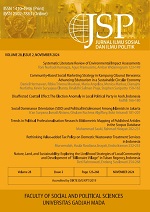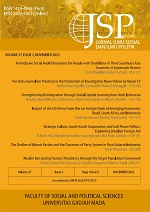Analysis of the E-Government Initiative at Local Government Level in Bandung City, Indonesia
Tutik Rachmawati(1*), Kusuma Dwi Fitriyanti(2)
(1) Department of Public Administration, Parahyangan Catholic University, Indonesia
(2) Department of Public Administration, Parahyangan Catholic University, Indonesia
(*) Corresponding Author
Abstract
This research aims to analyze aspects affecting the implementation of electronic parking, a digital- based public services provision in parking. The concept of digital divide, workforce, regulation, and infrastructure were used to conduct the analysis. This study employed a qualitative research methodology with qualitative data collection techniques through interviews with two officers of the Parking Technical Implementation Unit (TIU) - the Department of Transportation Bandung City Government, 4 parking attendants, and 100 people as the roadside parking users. To enrich the data, observation and study documents were also conducted. The research used a descriptive analysis combined with simple descriptive quantitative data. It is evident from this study that four primary aspects hindered the implementation of the electronic-parking initiative. Those aspects are a large gap in the digital divide, low workforce quality and quantity, the absence of the proper regulations, and futile infrastructure. Adding to these four barriers, we also found other significant aspects: the investment that has not been strategically designed, the lack of leadership, and the low quality of education and marketing. All these three additional aspects also contribute to the failure in meeting the objective of the electronic parking initiative. This finding suggests that any new initiatives in public service provision, mainly using ICT, need to be well communicated and consulted with the implementing units. Furthermore, the initiative needs to be complemented with an acceptable set of policies to ensure its sustainability.
Keywords
Full Text:
PDFReferences
Alcaide Muñoz, L., & Rodríguez Bolívar, M.P. (2018). Experiences of E-Government Development Implementation in Developing Countries: Challenges and Solutions. In L. Alcaide Muñoz & M. P. Rodríguez Bolívar (Eds.), International E-Government Development: Policy, Implementation and Best Practice (pp. 3–18). Switzerland: Palgrave Macmillan. https:// doi.org/10.1007/978-3-319-63284-1_1
Berto t, J. C., Jaeger, P. T., & Grimes, J. M. (2010). Using ICTs to Create a Culture of Transparency: E-government and Social Media as Openness and Anti-Corruption Tools for Societies. Government Information Quarterly, 27(3), 264–271. https://doi. org/10.1016/j.giq.2010.03.001
Brimkulov, U., & Baryktabasov, K. (2018). E-government Development in the Central Asian States: Best Practices, Challenges, and Lessons Learned. In L. Alcaide Muñoz & M. P. Rodríguez Bolívar (Eds.), International E-Government Development: Policy, Implementation, and Best Practice (pp. 121–154). Switzerland: Palgrave Macmillan. https://doi.org/10.1007/978-3-319-63284-1_6
Campos, J. (2009). Development in the Application of ICT in Condition Monitoring and Maintenance. Computers in Industry, 60(1), 1–20. https://doi. org/10.1016/j.compind.2008.09.007
Condrey, S. E. (2004). Handbook of Human Resource Management in Government (2nd ed.). San Francisco: Jossey-Bass. https:// doi.org/10.1080/09540968909387570
Cullen, R., & Hassall, G. (2017). E-government in Pacific Island Countries. In R. Cullen & G. Hassall (Eds.), Achieving Sustainable E-Government in Pacific Island States (pp. 3–32). Switzerland: Springer International Publishing. https://doi.org/10.1007/978-3- 319-50972-3_1
Gascó, M. (2006). Exploring the E-Government Gap in South America. International Journal of Public Administration, 28(7), 683–701. https://doi.org/10.1081/PAD-200064235
Hamner, M., Taha, D., & Brahimi, S. (2010). “Potential” Barriers to E-Government Implementation in Developing Countries. In C. G. Reddick (Ed.), Politics, Democracy and E-Government: Participation and Service Delivery (pp. 363–382). San Antonio, USA: IGI Global Snippet. https://doi. org/10.4018/978-1-61520-933-0.ch022
Hasibuan, Z. A. (2007). Langkah-Langkah Strategis dan Taktis Pengembangan E-Government untuk PEMDA. Jurnal Sistem Informasi MTI UI, 3(1), 66–70.
Helsper, E. J., & Van Deursen, A. J. A. M. (2015). Digital Skills in Europe: Research and Policy. In K. Andreasson (Ed.), Digital Divides: The New Challenges and Opportunities of e-Inclusion (pp. 125–146). London: CRC PRESS Taylor and Francis. https://doi.org/10.1201/b17986
Henman, P. (2010). Governing Electronically: E-Government and the Reconfiguration of Public Administration, Policy and Power. Basingstoke, United Kingdom: Palgrave Macmillan. https:// doi. org/10.1057/9780230248496
Ho, A. T.-K., & Ni, A. Y. (2004). Explaining the Adoption of E-Government Features: A Case Study of Iowa County Treasurers’ Offices. The American Review of Public Administration, 34(2), 164–180. https://doi. org/10.1177/0275074004264355
Jaeger, P., & Matteson, M. (2009). E-Government and Technology Acceptance: The Case of the Implementation of Section 508 Guidelines for Websites. Electronic Journal of E-Government, 7(1), 87−98.
Joseph, B. K. (2018). Designing Effervescent E-Government Solutions: Lessons from a Developing World Context. In L. Alcaide Muñoz & M. P. Rodríguez Bolívar (Eds.), International E-Government Development: Policy, Implementation and Best Practice (pp. 187–221). Switzerland: Palgrave Macmillan. https://doi.org/10.1007/978- 3-319-63284-1_8
Kireina, N. F. (2017). Mesin Parkir Elektronik sebagai Wujud dari Smart City di Kota Bandung. Jurnal Ilmu Sosial Dan Ilmu Politik, 7(2), 63–80. https://doi. org/10.15575/jp.v7i2.2272
Leon-Moreta, A., & Totaro, V. R. (2021). Workforce Capacity in Municipal Government. Public Administration Review, 81(2), 273–285. https://doi.org/10.1111/ puar.13155
Ludwig, T. (2017). Researching Complex Information Infrastructures. Germany: Springer Nature. https ://doi. org/10.1007/978-3-658-16921-3
Mahler, J., & Regan, P. M. (2002). Learning to Govern Online: Federal Agency Internet Use. The American Review of Public Administration, 32(3), 326–349. https://doi. org/10.1177/0275074002032003004
Merriam, S. B., & Tisdell, E. J. (2015). Qualitative Research:A Guide to Design and Implementation. San Francisco: Jossey-Bass.
OECD. (2009). Rethinking E-Government Services: User-Centred Approaches. OECD Publishing.
OECD. (2013). OECD E-Government Studies: Egypt 2012. OECD Publishing. https://doi. org/10.1787/9789264178786-en
Putra, M. A. P. (2014, December 29). Mengintip E-Parkir di Jalan Braga. Portal Berita Univeritas Pendidikan Indonesia. Retrieved from https://berita.upi.edu/mengintip-e- parkir-di-jalan-braga/
Qohar, M. T. (2018). Analisis Implementasi Kebijakan Terminal Parkir Elektronik di Kota Bandung. Jurnal Wacana Kinerja: Kajian Praktis-Akademis Kinerja dan Administrasi Pelayanan Publik, 21(2), 37. https://doi.org/10.31845/jwk.v21i2.108
Sosiawan, E. A. (2008). Tantangan dan Hambatan dalam Implementasi E-Government di Indonesia. Jurnal Online UPN Veteran Yogyakarta, 1(5), 99–108.
Trost, A. (2018). Human Resources Strategies : Balancing Stability and Agility in Times of Digitization. Germany: Springer International Publishing. https://doi. org/10.1007/978-3-030-30592-5
UNDESA. (2014). United Nations E-Government Survey 2014: E-Government for the Future We Want. Retrieved from https:// publicadministration.un.org/egovkb/ Portals/egovkb/Documents/un/2014- Survey/E-Gov_Complete_Survey-2014.pdf
UNDESA. (2020). E-Government Survey 2020: Digital Government in the Decade of Action for Sustainable Development. Retrieved from https://publicadministration.un.org/ egovkb/Portals/egovkb/Documents/ un/2020-Survey/2020 UN E-Government Survey (Full Report).pdf
VanDijk,J.A.G.M.(2006).DigitalDivideResearch, Achievements and Shortcomings. Poetics, 34(4–5), 221–235. https://doi.org/10.1016/j. poetic.2006.05.004
Welchman, L. (2015). Managing Chaos Digital Governance by Design. New York: Rosenfeld Media.
West, J. C. (2011). Without a Net: Librarians Bridging the Digital Divide. United States: Libraries Unlimited (An Imprint of ABC- CLIO, LLC).
Wohlers, A. (2010). Digital Governance. Choice Reviews Online, 48(04), 627–635. https:// doi.org/10.5860/CHOICE.48.04.627
World Bank. (2002). The E-Government Handbook for Developing Countries: A Project of InfoDev and the Center for Democracy and Technology (No. 32045; 1). World Bank Group.
Zulu, S. F. C. (2010). Emerging Information and Communication Technology Policy Framework for Africa. In E. E. Adomi (Ed.), Frameworks for ICT Policy: Government, Social and Legal Issues (pp. 113–134). United States: IGI Global. https://doi. org/10.4018/978-1-61692-012-8.ch008
Article Metrics
Refbacks
- There are currently no refbacks.
Copyright (c) 2021 Jurnal Ilmu Sosial dan Ilmu Politik

This work is licensed under a Creative Commons Attribution-NonCommercial-NoDerivatives 4.0 International License.























